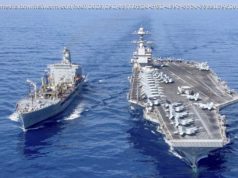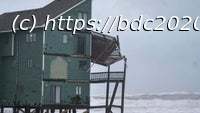A booster rocket failed less than two minutes after launching an American and a Russian toward the International Space Station on Thursday, forcing their emergency — but safe — landing on the steppes of Kazakhstan. It was the latest in a recent series of failures for the troubled…
BAIKONUR, Kazakhstan — A booster rocket failed less than two minutes after launching an American and a Russian toward the International Space Station on Thursday, forcing their emergency — but safe — landing on the steppes of Kazakhstan.
It was the latest in a recent series of failures for the troubled Russian space program, which is used by the U. S. to carry its astronauts to the station.
NASA astronaut Nick Hague and Roscosmos’ Alexei Ovchinin were subjected to heavy gravitational forces as their capsule automatically jettisoned from the Soyuz booster rocket and fell back to Earth at a sharper-than-normal angle and landed about 20 kilometers (12 miles) east of the city of Dzhezkazgan in Kazakhstan.
“Thank God the crew is alive,” said Dmitry Peskov, the spokesman for Russian President Vladimir Putin, when it became clear that they had landed safely. He added that the president is receiving regular updates about the situation.
NASA Administrator Jim Bridenstine, who watched the launch at the Russian-leased Baikonur cosmodrome along with his Russian counterpart, tweeted that Hague and Ovchinin are in good condition. He added that a “thorough investigation into the cause of the incident will be conducted.”
Hague, 43, and Ovchinin, 47, lifted off as scheduled at 2:40 p.m. (0840 GMT; 4:40 a.m. EDT) Thursday from Baikonur. The astronauts were to dock at the International Space Station six hours after the launch and join an American, a Russian and a German currently aboard the station.
But the three-stage Soyuz booster suffered an unspecified failure of its second stage about two minutes after launching. Search and rescue teams were immediately scrambled to recover the crew, and paratroopers were dropped from a plane to reach the site quickly.
While the Russian space program has been dogged by a string of launch failures and other incidents in recent years, Thursday’s mishap marked the program’s first manned launch failure since September 1983, when a Soyuz exploded on the launch pad.
It was to be the first space mission for Hague, who joined NASA’s astronaut corps in 2013. Ovchinin spent six months on the orbiting outpost in 2016.
The astronauts were flown by helicopter to Dzhezkazgan and then by plane to Baikonur. Russian officials said they may spend the night in Baikonur before being flown to Star City, Russia’s space training center outside Moscow, the Tass news agency said.
NASA posted pictures of Hague and Ovchinin undergoing a medical check-up at Dzhezkazgan’s airport. One of the pictures showed Hague smiling and another had him sitting next to Russia’s space agency chief Dmitry Rogozin.
Dzhezkazgan is about 450 kilometers (280 miles) northeast of Baikonur, and spacecraft returning from the ISS normally land in that region.
Flight controllers kept the three space station residents abreast of the situation after Thursday’s aborted launch.
“The boys have landed,” Mission Control assured the International Space Station crew.
Russian controllers told the space station astronauts that Hague and Ovchinin endured 6.7 times the force of gravity during their entry.
“Glad our friends are fine,” space station commander Alexander Gerst, a European Space Agency astronaut from Germany, tweeted from orbit. “Spaceflight is hard. And we must keep trying for the benefit of humankind.”
There was no immediate word on whether the space station crew might need to extend its own six-month mission.
Two spacewalks planned for later this month were off indefinitely. Hague was supposed to be one of the spacewalkers.
Russian Deputy Prime Minister Yuri Borisov said all manned launches will be suspended pending an investigation into the cause of the failure. He added that Russia will fully share all relevant information with the U. S.
Earlier this week, Bridenstine emphasized that collaboration with Russia’s Roscosmos remains important.
Relations between Moscow and Washington have sunk to post-Cold War lows over the crisis in Ukraine, the war in Syria and allegations of Russian meddling in the 2016 U. S. presidential vote, but they have maintained cooperation in space research.
The Russian Soyuz spacecraft is currently the only vehicle for ferrying crews to the space station following the retirement of the U. S. space shuttle fleet. Russia stands to lose that monopoly in the coming years with the arrival of SpaceX’s Dragon and Boeing’s Starliner crew capsules.
The last time the Russian space program had a manned launch failure was in 1983. Soviet cosmonauts Vladimir Titov and Gennady Strekalov jettisoned and landed safely near the launch pad after the Soyuz explosion.
Russia has continued to rely on Soviet-designed booster rockets for launching commercial satellites, as well as crews and cargo to the International Space Station.
While Russian rockets had earned a stellar reputation for their reliability in the past, a string of failed launches in recent years has called into doubt Russia’s ability to maintain the same high standards of manufacturing.
Glitches found in Russia’s Proton and Soyuz rockets in 2016 were traced to manufacturing flaws at the plant in Voronezh. Roscosmos sent more than 70 rocket engines back to production lines to replace faulty components, a move that resulted in a yearlong break in Proton launches and badly dented Russia’s niche in the global market for commercial satellite launches.
In August, the International Space Station crew spotted a hole in a Russian Soyuz capsule docked to the orbiting outpost that caused a brief loss of air pressure before being patched.






